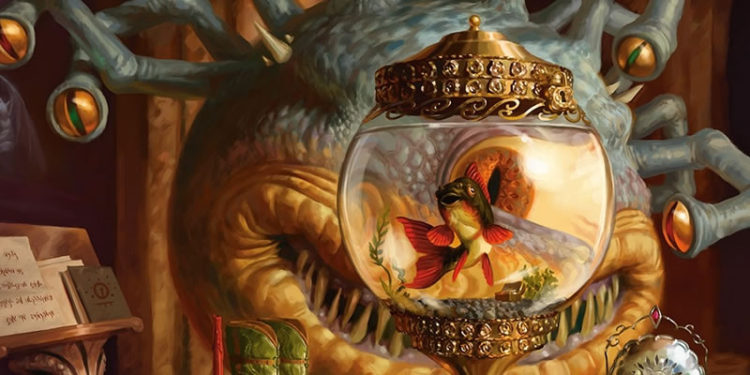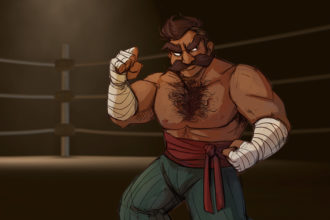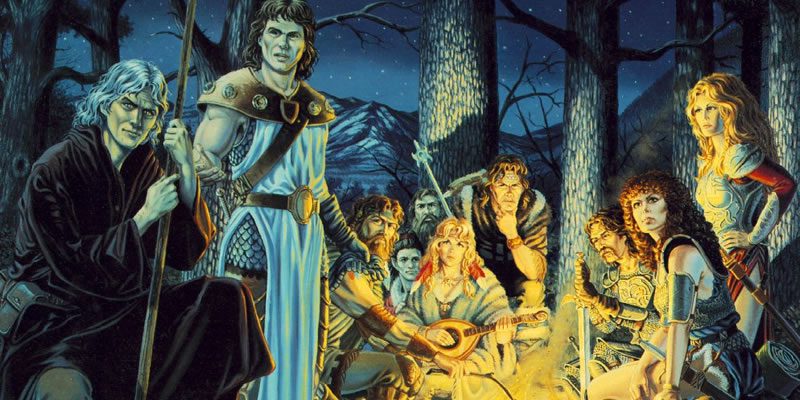
We’re getting close to the end of Xanathar’s Guide to Everything now, but Chapter Three: Spells is no joke. I wouldn’t count on me getting through this whole chapter in one article. I’ll be going through the spells in alphabetical order, and I’ll to note which classes get each spell, for conversational ease of reference. (It’s my one big complaint about how spell information is presented – you have to flip back and forth between the class lists and the descriptions to figure out who gets what. Duplicating the information would have taken space but increased utility.)
Barbarians and Bards | Clerics, Druids, and Fighters | Monks and Paladins | Rangers and Rogues | Sorcerers, Warlocks, and Wizards | Backstory and Feats | Rules Clarifications and Encounter Building | Traps, Downtime, and Magic Items | Spells
The new spells are a combination of reprints from the Elemental Evil Player’s Companion, classic spells that every edition releases in its first big splatbook of spells, UA content, and all-new material. I’ll also be referencing the Spell Damage table (DMG p. 284) a fair bit to talk about “expected” damage. It’s a guideline that WotC observes chiefly in the breach – fireball and lightning bolt, you are some top offenders.
Abi-Dalzim’s Horrid Wilting (Sorcerer, Wizard): Always one of my favorites, this is top-end necromantic murder. It almost makes Grim Harvest a good feature! Except that it’s an AoE and perfect for killing more creatures in a round than Grim Harvest pays you for. (I have Opinions on the School of Necromancy.) Anyway, this deals a pile of necrotic damage to creatures in a large area, though it doesn’t affect constructs or undead – which I assume are common opponents in a lot of games at 15th level and up. It averages 54 damage, placing it between the 12d10 of single-target spells and the 13d6 of area effects. My last point on this is why the hell isn’t it on the warlock list? Um, get used to hearing that, it’s gonna keep coming up. This would be a perfect Mystic Arcanum.
Absorb Elements (Druid, Ranger, Sorcerer, Wizard): This reaction spell prevents some incoming damage and stores a little of it in your melee attack. This is a great spell for melee rangers and any druids, sorcerers, or wizards that want to get into melee – though to be fair, a reaction to grant yourself resistance to an energy type is good enough by itself. It’s an especially good look for a Beast Master ranger with the Share Spells feature.
Aganazzar’s Scorcher (Sorcerer, Wizard): For reasons I don’t quite grasp, this spell has almost as rich a history in D&D-based video games as it does in text. Not looking it up right now, but did it show up in a video game first? Anyway, seeing it here is like running into an old friend. It’s like burning hands’ big brother. Its damage output is within half a point of the target for an area effect.
Beast Bond (Druid, Ranger): This is another great spell for Beast Master rangers, like you’d expect from the name: it’s a whole lot of advantage for your beast’s attack rolls, as long as you’re adjacent to same target. I’m happy to see all this support for the casting side of the Beast Master, since hunter’s mark is not great for them. It also fits in nicely with a druid using animal friendship to recruit help. I mean, assuming you can afford two 1st-level spells and the use of your concentration.
Bones of the Earth (Druid): When druids get serious about reshaping the terrain, it gets real in a hurry. This is a pretty complex spell, though not out of line for 6th level. I like its visual theme. It’s about creating barriers in the battlefield, lifting creatures out of harm or forcing them to take falling damage to get back to the fight, and creating difficult terrain. Underground, it deals its damage more directly, smashing you against the ceiling if it can. You can also use it to build a staircase (the pillar height is “up to” 30 ft), though there are probably more efficient ways to do that in almost any party configuration.
Catapult (Sorcerer, Wizard): This is a single-target direct damage spell with a twist – it has no effect on a successful save, but it keeps going for a nice long distance until it hits something. My wife’s Theurge used this to good effect last Saturday. Its damage output is right where you’d expect for a single-target spell with no effect on a successful save – so choose your trajectory wisely.
Catnap (Bard, Sorcerer, Wizard): This is an unusual utility spell, letting you reduce short rest time to 10 minutes for a few party members. I admit that I haven’t seen a ton of cases where this would make a difference, but I’m not in a lot of games with a “standard” number of rests per day. I probably wouldn’t make this a priority pick for a bard or sorcerer, because Spells Known is a harsh mistress.
Cause Fear (Warlock, Wizard): Man, I love how many necromancy spells do nothing to constructs or undead. Bleh. Anyway, this is a single-target frightening effect. It scales very nicely – one target per spell level – and is situationally as good as fear (the 3rd-level spell). Sometimes you really don’t want enemies to run away, and can’t establish a 30-ft cone without hitting allies.
Ceremony (Cleric, Paladin): I talked about this spell a lot when it debuted in UA, so I’ll briefly say that I love what this spell offers for world-building, but I’m sad that neither this spell nor a cognate of it shows up for druids. Don’t druids fill a similar religious and cultural role as part of their default story? I suppose a druid who wanted to emphasize their role as a medicine worker or holy person of a nature faith could pick up Ritual Caster (Cleric) or Magic Adept.
Chaos Bolt (Sorcerer): This is a rare case of a spell unique to sorcerers, and a clear nod to the Wild Magic origin. Its damage output is on the low side of the expectation for a single-target spell that has no effect on a miss, but it also has a 12.5% chance to jump to another target, and if that hits, another 12.5% after that, and so on. It’s stylish, but not likely to deal its most impressive damage very often at all. Tides of Chaos and Bend Luck can’t help the “jump” chance, but they’re good for making sure a successful “jump” hits its target. I do think it would have been a good candidate to give to warlocks.
Charm Monster (Bard, Druid, Sorcerer, Warlock, Wizard): This spell was a glaring omission from the Player’s Handbook and I am sad it is not part of the SRD, because it would make some of my freelance PF-to-5e conversion work easier. Feh. Anyway, this works exactly like a read of charm person would lead you to expect.
Control Flames (Druid, Sorcerer, Wizard): Of all the elemental transmutation cantrips, I think this one should have gone to warlocks as well. Anyway, it’s a situational utility effect, probably at its best if you need to extinguish a spreading fire.
Control Winds (Druid, Sorcerer, Wizard): If you think of this as an unconventional terrain-creating spell, you’re pretty much on the money. Gusts disrupt missile weapons and create difficult terrain (that isn’t called difficult terrain, so it gets around features that let you ignore difficult terrain). Downdrafts give flyers a very bad day and disrupt missile weapons. Updrafts halve falling damage and increase jump height. I’m not sure that any one of these is worth a 5th-level slot unless you’re facing massed arrow-fire, participating in a set-piece battle, or fighting flyers that will consistently fail Strength saves, but having all three together, and shifting between them as an action, is probably worthwhile. Hard to say.
Create Bonfire (Druid, Sorcerer, Warlock, Wizard): This cantrip was first released in the EEPC, and it is very strange. Not a lot of attack cantrips require concentration, but that’s a major part of the balance here. If you can reduce a creature’s speed to 0, through grappling, the restrained condition, or whatever else, you can just keep damaging it round over round while also pummeling it with your primary attack cantrips or other spells. It’s also perfect for 5-ft chokepoints, though if those were common, cloud of daggers would be a good spell.
Create Homunculus (Wizard): I am not sure that the homunculus stats are compelling enough to make this spell a good idea for PC wizards very much of the time, but I am so excited to see wizard-created homunculi in D&D that I almost don’t care. So, for those who don’t know, the Dust to Dust campaign that Colin, several others including my wife, and I ran had homunculi as a PC race. They were more “Frankenstein’s monster” than “weird bat-thing.” I loved their story so much. Anyway, this spell probably more for NPCs than PCs, and that’s fine. It’s a shame that Mystic Arcana work the way they do, because I would like warlocks to have this access to this, but it’s a terrible choice for a Mystic Arcanum.
Crown of Stars (Sorcerer, Warlock, Wizard): This is a damage-dealing spell that you cast in advance and expend slowly, using your bonus action and a ranged spell attack. Its total damage output of 28d12 – an average of 182 damage – is just bananas compared to a single-target expected damage of 60.5 (11d10) for a standard 7th-level spell. Sure, it’s sustained damage rather than burst damage, but damn. Enemies at least know you’ve got something going on while this spell is active, even if they don’t recognize the effect at first. The spell’s 1-hour duration does present a worrying worst-case, where you spend only a few of the motes before your party needs another short rest… and the spell ends. (This spell directly makes catnap better.)
Danse Macabre (Warlock, Wizard): Clerics should really have a way to get this spell, for the more sinister deities. Anyway, this is the spell that probably a lot of players want animate dead to be: a quick “Rise, my minions!” and suddenly you have a small army. It’s also a shame that the Undead Thralls feature only affects undead created with animate dead, and so can’t boost this. Not that it needs the help, so much as that this feels like what Undead Thralls should be for.
CORRECTION (3/3/18): I am annoyed beyond all reason to discover that I misread Undead Thralls when I checked it for this writing. The hit point boost and damage boost of Undead Thralls – you know, the really important part? – works fine with danse macabre. Many thanks to Meeya Candelaria for kicking me in the pants on this one.
Dawn (Cleric, Wizard): This is moonbeam on major performance-enhancing drugs. It is called out as being sunlight, so vampires beware. The 30-foot radius, 60-foot range, and “each creature” combine to make it… tactically difficult in a lot of situations. Evokers should absolutely chase this spell, because Sculpt Spells means you’re ignoring up to 6 targets. That’s, let’s say, an auspicious number in most gaming groups.
Dragon’s Breath (Sorcerer, Wizard): This spell confers a breath attack on another creature. It’s a bonus action to cast and an action to use, so it’s a great round-before-combat-starts buff for giving a melee ally an AoE. I missed this on the first read, but the spell doesn’t end when first used. It lasts for a minute, so your ally can just keep blasting away for as long as that’s a better idea than their native at-will attack options. Very strong.
Druid Grove (Druid): This spell is someone very wisely realizing that druids need their own guards and wards, natural-terrain-only variant. I’m glad it exists on that level. Beyond that, it also makes me want to see tower-defense-style fights, rewarding the PCs for terrain modification and murdering scads of mooks. Even without this spell, druids are phenomenal at that. Also, this spell doesn’t require concentration. The material component is a nod back to the brutal requirements of the 1e druid, though it’s “any full moon” and not “midsummer.” It’s difficult enough, and consumed on use, that even though it doesn’t have an attached price tag, it feels like it should.
Dust Devil (Druid, Sorcerer, Wizard): This is the airy version of flaming sphere, tacking on a knockback and a sandstorm effect. It’s possible to turn this into a pile of damage, but it takes some doing. If you’re casting this, you need to be thinking about how to use a mobile heavily-obscuring cloud effectively. For example, it annoys the crap out of spellcasters if their spells include “that you can see” clauses.
Earthbind (Druid, Sorcerer, Warlock, Wizard): Basically this. The flyers you most want to bring down – hint, they’re in the game’s name – aren’t going to fail Strength saves, though. Anyway, this is good to have, but because it’s so specialized, it’s much, much better for druids and wizards than sorcerers or warlocks. Great candidate for having a scroll or two tucked away, since it doesn’t reward casting with higher spell levels anyway.
Earth Tremor (Bard, Druid, Sorcerer, Wizard): This is a point-blank AoE that breaks up the earth, creating difficult terrain and causing minor damage and knockdown. If you’re positioning yourself to use this optimally, either you’re a Valor bard or you’re making a really questionable decision. On the damage side, you’re paying half of the expected AoE damage for that knockdown, as well as difficult terrain that is as good for you as bad. If you can cast this and run without getting murdered by opportunity attacks, that’s probably your best-case scenario – prone + difficult terrain is a lot of slowdown.
Elemental Bane (Druid, Warlock, Wizard): This spell imposes a pseudo-vulnerability on your target and strips away resistance. It’s a great debuff if every member of your party has access to a particular damage flavor. See where it says “first time on each turn”? That is huge. No effect on a successful save, though. The At Higher Levels effect is a really big deal, making this an amazing prelude to a unleashing a hell of fireballs or whatever. Admittedly, we’re talking about some expensive, high-priority spell slots. It’s fairly involved to use well, but has a lot of promise.
Enemies Abound (Bard, Sorcerer, Warlock, Wizard): This is an unusual debuff, in the general theme of confusion but single-target and more comprehensive in its effect. Targeting Int is devastating in the general span of published monsters. The spell’s effects require some thought to use properly, but the best-case scenario is phenomenally devastating. I would love to know the thought process that went into choosing its spell level.
Enervation (Sorcerer, Warlock, Wizard): Here’s a case of going back to a common spell of earlier editions that got left out of the Player’s Handbook. Also it’s basically this. This spell fixes several of the problems of witch bolt: it has an effect on a successful save (if an underwhelming one), and its recurring action damage scales as well as its initial damage at higher spell levels. On the other hand, its vampiric damage property is incredible, so you don’t need this to work for very long to make it phenomenal. If you have a grappler teammate or a source of the restrained or paralyzed conditions, this goes from okay to off-the-charts good (assuming you have taken some damage, anyway).
Erupting Earth (Druid, Sorcerer, Wizard): This has a lot of conceptual overlap with Earth Tremor, but it’s a long-range area spell rather than point-blank AoE. Its damage output functionally trades a point and a half (that’s pretty marginal, for most purposes) for creating difficult terrain. It’s fine for what it does, but doesn’t have a lot to recommend it over other long-range area spells. After all, a 20-foot cube is a lot smaller than a 20-foot-radius sphere.
Far Step (Sorcerer, Warlock, Wizard): This is a 1-minute misty step, with a 60-foot rather than 30-foot range. Combat-range teleportation is incredibly good, and this spell gets the job done.
That’s twenty-eight spells so far, and that’s it for this week. Up to this point, the spells look very good, but we haven’t hit the controversial ones yet. Thanks for reading!



